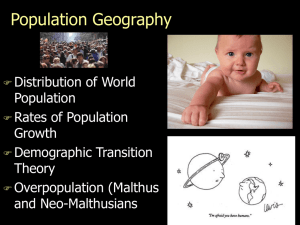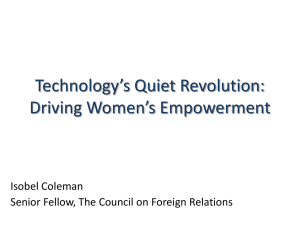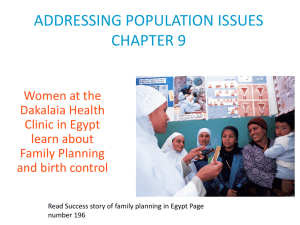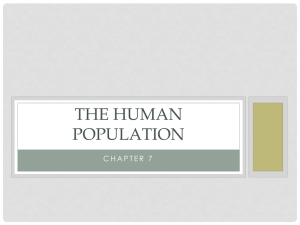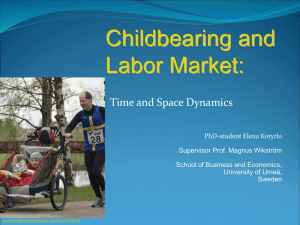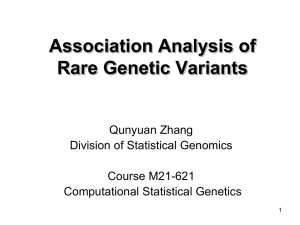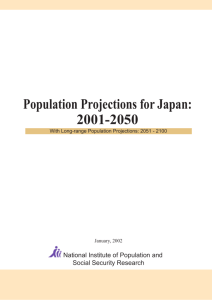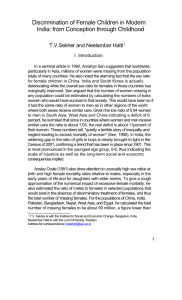Avoid Middle Income Trap
advertisement
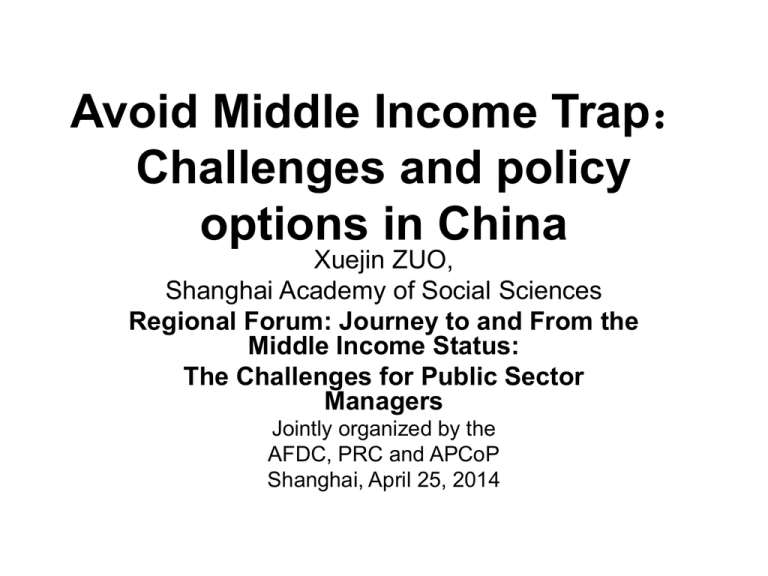
Avoid Middle Income Trap: Challenges and policy options in China Xuejin ZUO, Shanghai Academy of Social Sciences Regional Forum: Journey to and From the Middle Income Status: The Challenges for Public Sector Managers Jointly organized by the AFDC, PRC and APCoP Shanghai, April 25, 2014 • After decades of high growth, China’s economic growth rate is slowing down, from around 10 percent to below 8 percent (7.8 percent in 2012, 7.7 percent in 2013) . Further decline is projected by many studies. • Slower growth leads to concerns on whether China would fall into “middle income trap.” • The concerns come from two major facts: – Demographic changes and the phasing out of the demographic bonus; – The government interference into the microeconomic activities causing inefficient allocation of resources and the related risks. Demographic Changes in China • China’s population has been experiencing a long-term change featured by • very low fertility (below 1.5) and projected negative growth rate • prolonged life expectancy • progressive aging of the population. The 2010 Census Data • The sixth population census data reveal that in 2011, the total population in China’s mainland was 1.34 billion,increasing by 5.84% over 2000-2010. The Sixth Population Census • The sixth population census reports that in China’s mainland the total population amounted to 1.34 billion, grew by 5.84 percent in the last decade, averaging 0.57 percent per annum, below 0.5 percent since 2010. • The data reveal the trend of low growth rate and rapid aging of the population. The Sixth Population Census -2 • The young population aged 0-14 accounted for 16.60% of the total, declined by 6.29 percentage point as compared to the fifth census in 2000; • The elderly 60 and older accounted for 13.26%, increased by 2.93 percent, the elderly 65 and older accounted for 8.87%,increased by 1.91 percentage points. • A simple comparison of data from the past censuses clearly show a long trend of population aging. Total size and age structure of the population as reported by census Year Total (million) 594.35 Aged 0-14 (%) 36.28 Aged 15-64 (%) 59.31 65 and older (%) 4.41 1953 1964 694.58 40.69 55.75 3.56 1982 1008.18 33.59 61.50 4.91 1990 1133.68 27.69 66.74 5.57 2000 1265.83 22.89 70.15 6.96 2010 1339.72 16.60 74.53 8.87 Growth, births and deaths, 1949-2010 出生率 (‰) 死亡率 (‰) 自然 增长率(‰) 50 40 30 20 10 0 19 49 19 53 19 57 19 61 19 65 19 69 19 73 19 77 19 81 19 85 19 89 19 93 19 97 20 01 20 05 20 09 -10 Total population as projected by UN: Medium Variant • UN World Population Prospects (the 2010 Revision) projects that China’s population will start to decline in 2026 at the peak of below 1.4 billion. • At the end of this century, China’s total population will shrink to 941 million. Low Variant • According to the low variant,China’s population will start to decline in 2017 at the peak of 1.36 billion, falling to merely 506 million at the end of this century, smaller than in 1949. • Either variant projects that turning point of china’s population from positive to negative growth will occur in the next 5 to 14 years. China’s Projected Total Population, 2010-2100 (million) Assumption on Fertility • The main cause of population decline is low fertility. • I did not show you the high variants, only because its fertility assumption seems too high. Assumption on Total Fertility Rate (TFR), 2010-2100 China’s TFR might be lower than the medium-variant assumption • The UN medium variant assumes that China’s TFR would increase from 1.51 in 2015-20 to 2.01 in 2100 might overstate the future fertility, if compared with the real changes in the abovementioned neighboring countries/regions. • By analyzing the data from the 6th Census Guo Zhiang (2012) found that the China’s real fertility were below 1.5 in the past decade, and even below 1.4 for some years. • Based on the trend of the future fertility change, the real growth of China’s population might between the low- and medium-variant projections; that is, China’s total population will be between 500 million to 900 million at the end of this century, or about 40% to 70% of the total at the end of 20th century. Changes in Age Structure: Working-age Population • China’s working-age population aged 15-64 declined by 3.45 million in 2012. It is the beginning of a long-term trend. • The UN median variant projects that China’s workingage population will increase from 971 million in 2010 to 996 million in 2015, falling gradually thereafter to 526 million in 2100. After 2075, the working-age population will account for just over 55% of the total. • The low variant reports that China’s working-age population will shrink to 258 million in 2100. After 2075, the working-age population will account for merely half of the total population. China’s Working-Age Population (aged 15-64), 2010-2100 (million) China’s Population Elderly 65+, 2010-2100 (million) China’s Population Elderly 65+, 2010-2100 (% of total) International Comparison: Total Population (UN medium variants) International Comparison: Growth Rate (UN medium variants) International Comparison: Percent 65+ (UN medium variants) Economic Impacts of Demographic Changes • Increased scarcity of labor supply and costs, the consequent change in comparative advantage of the economy. • Population aging and its effects on saving/investment rate. • On financing of social security system. • On innovation. • Discussions on China’s falling potential growth rate. Related Policy Issues • Inadequate investment on human capital: – Local governments prefer more seeable “hardware” investment than human capital investment. – Fiscal spendings on education has remained at low level (4 percent of GDP in 2012) – Inequal distribution of such spendings between rural and urban areas, and between primary/secondary and tertiary education. Issues on “Shallow Urbanization” or “Half-Urbanization” • By the end of 2013, China’s peasant workers totaled 268.94 million, of which majority were worker in cities. • These peasanat workers in cities was statistically accounted as “urban”, however, do not get the equal rights as urban citizens in employment, social security, eduation and health care. • In 2013, there were over 60 million rural children left at home villages by their migrant parents, and 35.81 million non-registered migrant children in cities. • Neither left-behind children or migrant children get adequate investment in their education, health care and even parental love. Short-Term Employment of Peasant Workers • Labor contract law and social insurance law mandates that the employer assign permanent contracts with workers after two terms of contracts. However, none of the peasant workers got such permanent contracts. • The key is to create institutional arrangement which prevent welfare losses of workers in the process of mobility. • The reforms in pension and health care are most important. the role of the governemnt • The active involvement of the local government in economic growth, esp in the allocation of factors such as capital and land. • China’s transition from industrialization to post-industrialization requires the transition of the role of the government. China’s land institution 1. 中国的土地所有制:城镇土地国家所有, 农村土地农村集体所有 2. 农村土地转变为城镇建设用地,需先由政 府征收。 3. 政府按农业用地补偿农民。 1. Overuse of land by the local governments,土地城市化快于人口城市 化;有利于制造业的发展而不利于服务业 的发展,工业园区使用大量土地但是土地 使用效率低下,由制造业向服务业的转型 困难 2. Local governments’ heavy reliance on revenues derived from land sales. Financial depression and risks • High concentration ratio of financial secor, 一方面是产能过剩和资金利用效益下降, 另一方面为中小企业服务的中小金融机构 短缺,中小企业尤其是实体经济融资成本 过高 • Fast growth of local government’s debts, 投资回报率不断降低,产能过剩、造城运 动与房地产市场形成的泡沫,及相关的金 融风险引起普遍担心 The development of SME’s • 中国政府对微观经济活动的干预和直接参与过多 • 三中全会决定明确要进一步转变政府职能,减少 政府行政审批 • 根据世界银行2013年中小企业商务环境报告,中 国在185个经济体中排名第91名,大致处于中游 水平。 • 相比之下,新加坡排名第一,我国香港排名第二, 新西兰排名第三,美国排名第四,韩国排名第八, 我国台湾排名第16,泰国排名第18,日本排名第 24。 • 在10项指标中,我国排名比较靠后的有 – 申请建筑许可(排名第181位), – 开办新企业(排名第151位),税费负担(排 名第122位), – 获得电力供应(排名第114位)等。 • 由于我国人均GDP已经进入上中收入国家 行列,中小企业商务环境却相对靠后,表 明我国在改善中小企业商务环境方面还有 很大改进的空间。 Policy Suggestions • 1. Invest more in human capital • 随着我国人口红利的逐步终结和人口老龄 化的进展,我国经济增长需要越来越多地 依靠知识和技术进步,归根到底依靠人力 资本投入的增长来推动。 • 首先需要我们加大对人力资本的投入,提 高这种投入的公平性和效率。 • 我国在近年内应考虑将义务教育延长到高中阶段 (12年)。 • 提高城乡义务教育均等化程度。改善留守儿童和 流动儿童的教育、健康和生活状况 • 可通过中央财政分担部分教育经费的办法来鼓励 地方政府向非户籍人口提供义务教育。 • 我国人口的少子化(2010年普查数据表明中国014岁人口占总人口比例仅为16.6%)和人均国民 总收入的不断增长,为增加教育投入,尤其是增 加财政对义务教育的投入创造了非常有利的基础 性条件。 • 加快我国医疗卫生体制改革,作为第一步, 为全体人民提供廉价可及的一级和二级医 疗服务,减少穷人因疾病与事故等原因陷 于贫困无助的境地,减少可避免的早夭。 Promote the more efficient use of labor • 加快形成全国统一的劳动力市场,消除造成城市 “浅城市化”问题的制度原因,为劳动力和人才 在全国和城乡间的自由流动创造更好的制度环境: – 向在城市就业和纳税的外来务工人员,提供均等化的 公共服务,首先是他们的女子的义务教育; – 确保他们有权参加各类社会保险,尤其是社会养老保 险和社会医疗保险,在基础层面(或第一支柱),与 城镇职工同样缴费,同样享受保险权益; – 确保他们享受公平的、非歧视的就业机会和劳动保护。 Reform the land institution for better use of land • 土地制度最关键的改革:按公平的市场价 格向农民征收土地,使土地价格能更好地 反映土地的稀缺性,减少对土地资源的滥 用。 • 政府可以向征地农民征收合理的税收,以 及预留社会保障基金。 Reform the financial sectors • 降低中国金融业的集中程度,发展为中小 企业和农村经济服务的中小金融机构,发 展普惠金融 • 控制地方政府债务过快增长,改革对地方 政府官员的考核办法,加强中央和公众对 地方政府基础设施建设项目和房地产项目 的监督 • 逐步推出房地产税,控制对房产的投资 (投机)需求 Improve business environment g • 减少政府对微观经济活动的直接参与和干 预,减少不必要的行政垄断,发展公平竞 争和鼓励创新的市场环境 Further relax of fertility control policy • 为了避免未来的中等收入陷阱,我们还要 防止代际数量关系的严重失调,即未来劳 动年龄人口(中青代世代)相对于未来的 退休老年人数量过少。 • 在实行单独生二胎政策后进一步适时调整 生育政策,首先允许所有城乡家庭生育二 胎,然后放开生育限制,必要时鼓励生育。 谢谢大家! Questions and Comments are welcome! Thank you!
